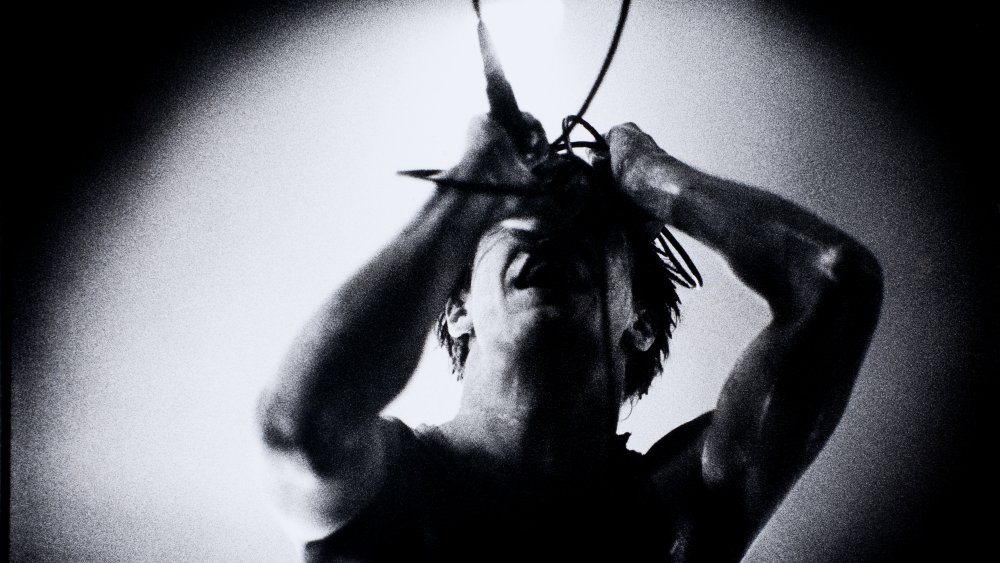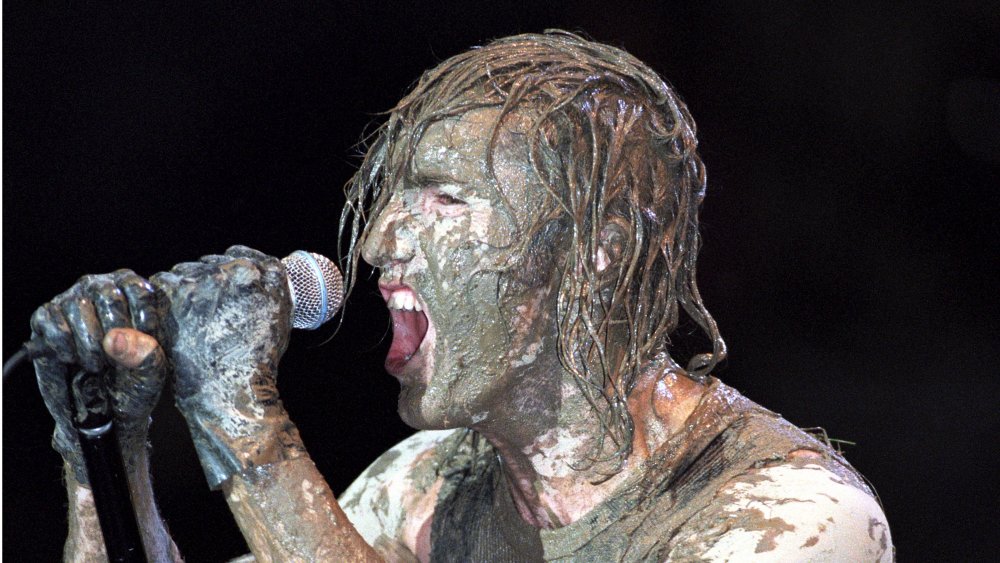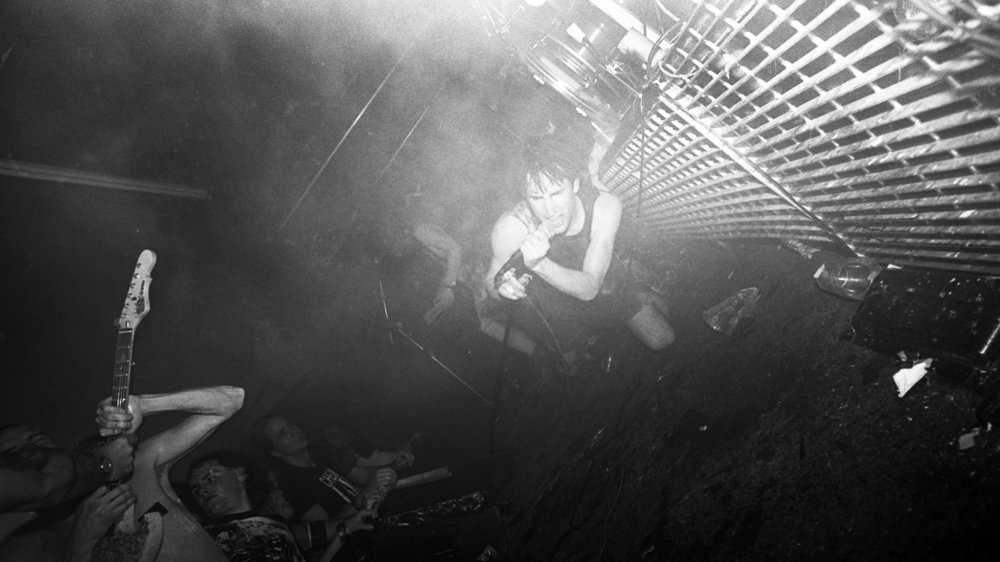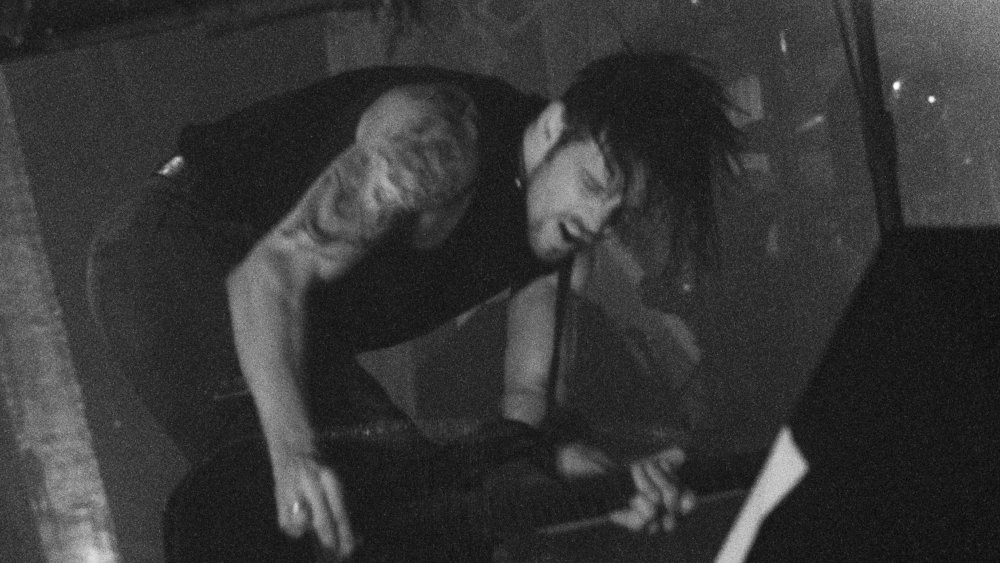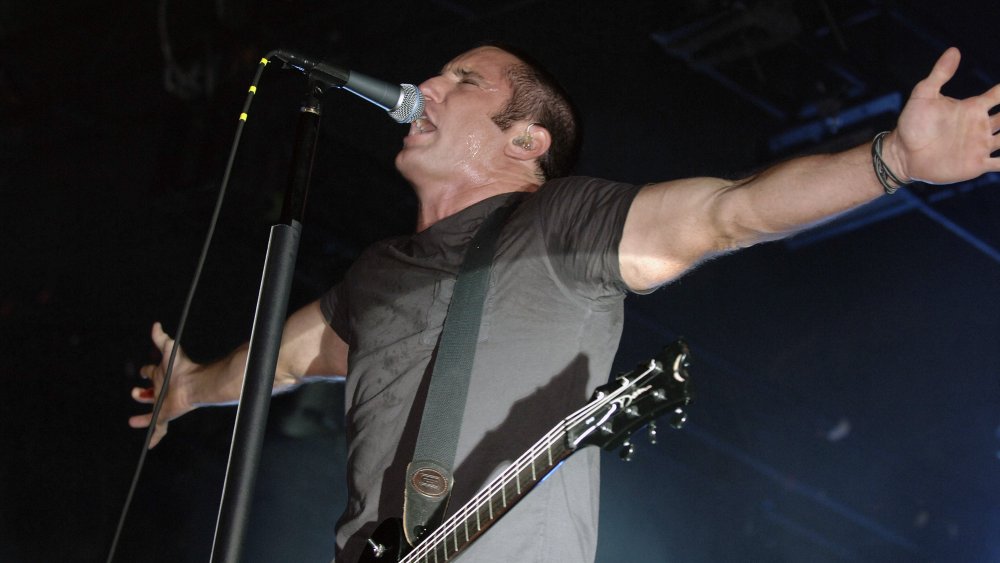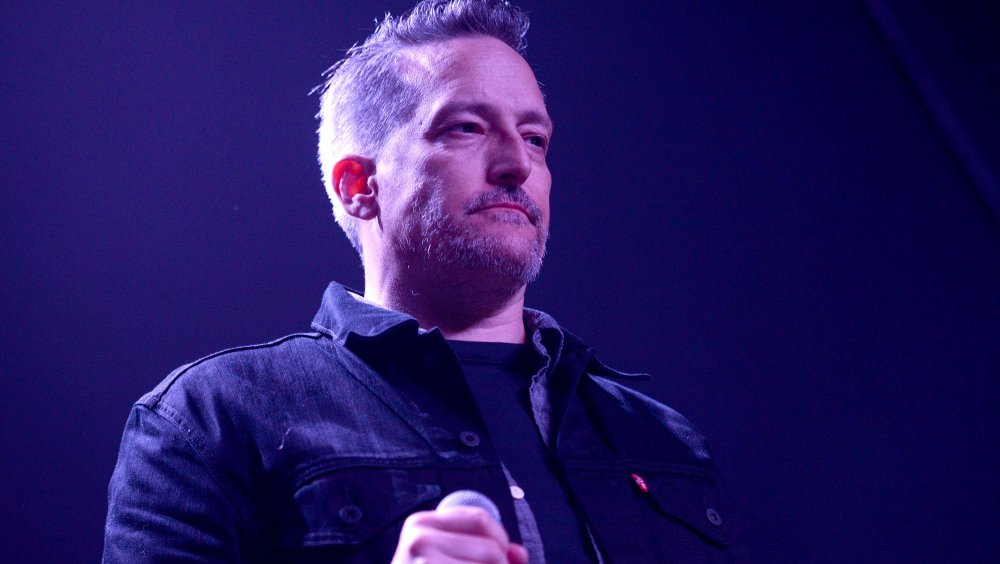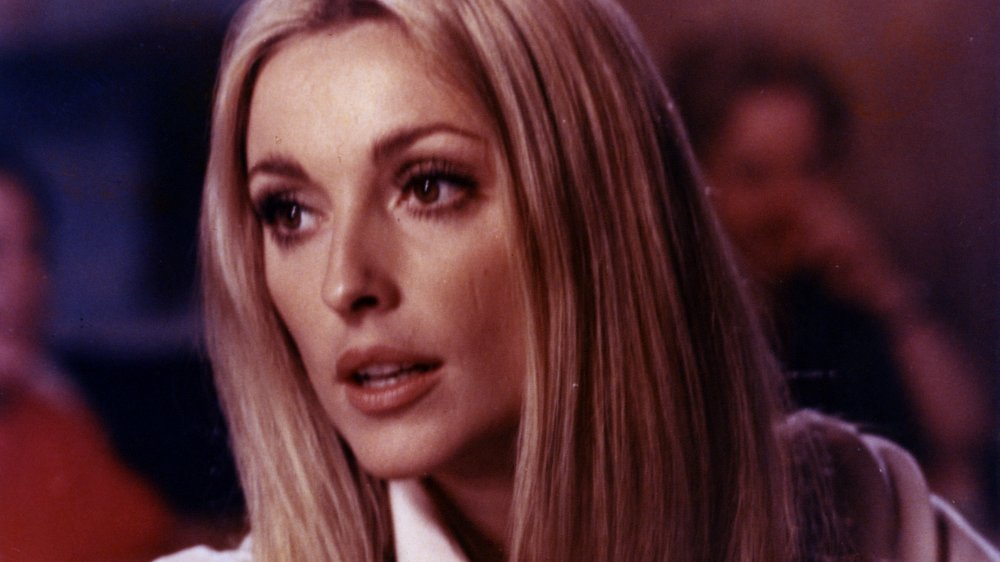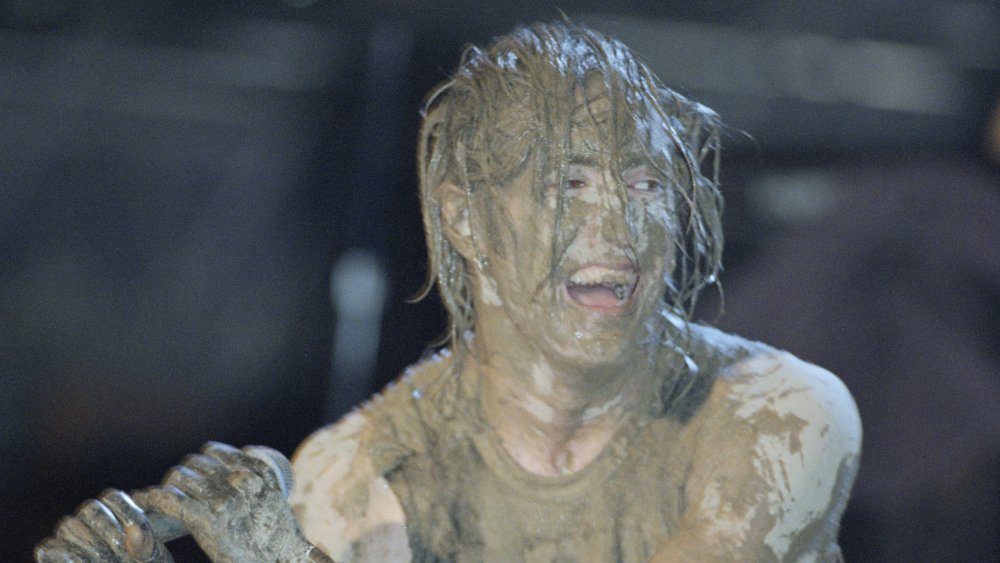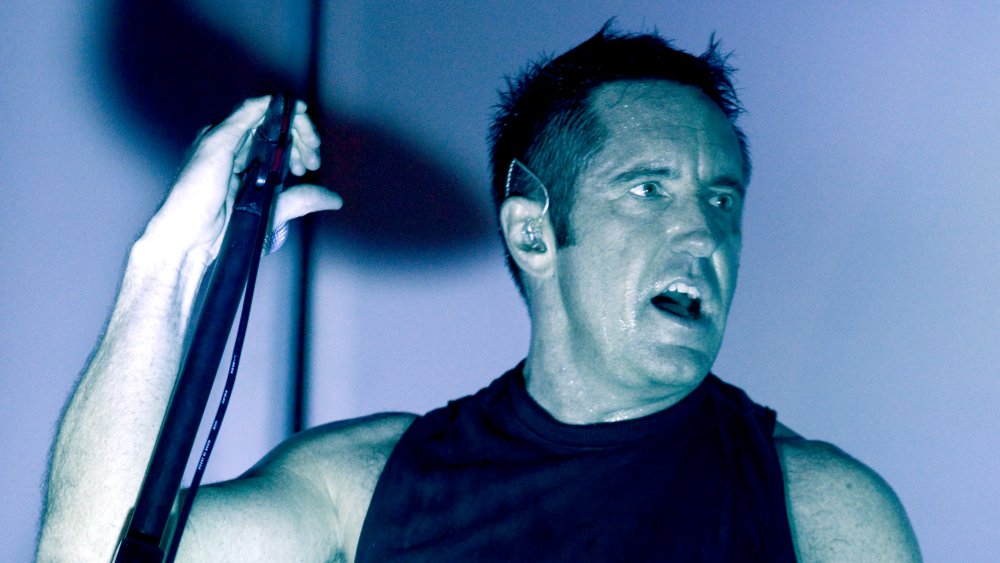The Tragic Real-Life Story Of Nine Inch Nails
The early '90s were dominated by grunge (no relation). Gone were the synths and drum machines of the new wave '80s, replaced with guitars and a whole lotta distortion. The fashion-forward synth-pop bands of the Reagan administration faded away, replaced by dudes with questionable hygiene in flannel and jeans.
Hardly anyone was still making music with electronic instruments, with one of the notable exceptions being Nine Inch Nails. Inspired by '80s industrial acts such as Skinny Puppy and Ministry, the band, who was really just Trent Reznor and a series of touring musicians and collaborators, took things in a more accessible direction with catchy, almost pop-like songs, with pounding drums, samples, and analog synthesizers.
Since those days, the band has won Grammys, sold millions of records, and even ended up with a Country Music Award. But it wasn't easy getting there, and Reznor and crew struggled a lot along the way. Here is the tragic real-life story of Nine Inch Nails.
Trent Reznor started out as a janitor
Many of the newest musicians you hear have one major thing in common — they're all young. Your typical musician starts around age 20, and many are even younger. Trent Reznor was in his mid-20s, practically a dinosaur, and living in Cleveland, Ohio — not exactly a major music hub.
It had a respectable number of bands, though, and Reznor had played keyboard in a few of them, such as Exotic Birds. But in the late '80s, Reznor wasn't happy. He wanted to make his own music. So he took a pretty weird and risky path to get there. Reznor got a job as a maintenance man at Cleveland's own Right Track Studio. The pay was presumably not fantastic, but Reznor and owner Bart Koster had a deal: Reznor could use the studio to record demos whenever no other bands had booked it, according to AllMusic.
So that's what Trent Reznor did. "He is so focused in everything he does," Koster once told People. "When that guy waxed the floor, it looked great." Waxing floors by day and recording demos by night, Reznor soon had a set of demos for his new project, which he called Nine Inch Nails (so-named because it abbreviated nicely to NIN and Reznor just liked the sound of it, contrary to numerous urban legends about how he came up with the band's name). It surely wasn't the easiest or most exciting way to break into the industry, but it paid off when the demos started attracting record labels.
Nine Inch Nails' first album was essentially a solo effort
While Trent Reznor knew several fellow musicians in the Cleveland music scene, he had trouble finding anyone he felt was a good fit to play the material he had written for his demos and was willing to work his odd 3 to 8 a.m. hours, so he just recorded everything himself, according to Option Magazine. A multi-instrumentalist, he handled keyboards, programming, guitars, bass, and everything else.
When Reznor finally scored a record deal with a little-known label called TVT Records, and it was time to start recording Nine Inch Nails' first album, Reznor just kept making a lot of the band's music himself, save for some contributions from people such as guitarist Richard Patrick and former Exotic Birds bandmate Chris Vrenna on drums.
This ended up being a trend for future Nine Inch Nails records, with Reznor doing as much as could on his own with only occasional input from other musicians. This also had the side effect of alienating Reznor from others around him, a pattern that would later become entwined with persistent depression and drug and alcohol addiction. It wasn't until Reznor met Atticus Ross working on the band's 2005 album "With Teeth" that he found someone he could work with all the time, eventually leading to Ross becoming the only other permanent member of the band in 2016.
Their first big single was an admitted rip-off of another band's song
By 1989, the band's first album, "Pretty Hate Machine," was nearly ready and it was time to release a single. They selected "Down In It," which was the first song Trent Reznor had ever written. It was a dance club-ready but still rock-influenced song with lyrics about depression, negative self-image, and some hints of drug abuse, thus ensuring it would fit in with the dark, introspective lyrics popular in alternative rock in the '90s.
The song didn't make it anywhere near the charts, but it did catch the attention of some industrial music fans who pointed out the song was incredibly similar to another song released by Canadian industrial band Skinny Puppy in 1986. Skinny Puppy's track "Dig It" came out three years earlier, and coincidentally, it was their first single as well. Rumors even flew around that Nine Inch Nails used some of the exact same samples in their song. These accusations never made it into mainstream music criticism, and it's probably good for Nine Inch Nails that they didn't.
Several years later, Reznor finally admitted "Down In It" was absolutely a rip-off of "Dig It," according to The NIN Hotline. While all sorts of famous songs have intentionally or accidentally ripped off other songs, and music consumers never really noticed, it probably wouldn't have been a good look for their first big single to come under fire for essentially copying another song.
Their first music video caught the attention of the FBI
While few people noticed the similarities between "Down In It" and "Dig It," its video raised many more eyebrows — namely those of the FBI, according to Mental Floss. The video, filmed on a shoestring budget, features Trent Reznor and members of his touring band in an empty parking garage, throwing bottles, and dropping a TV off of the garage roof.
For the video's final shot, Reznor's character was supposed to look like he fell off the roof as well, so he laid on the ground with fake blood around him and cornstarch smeared on his face. The idea was to attach the camera to a weather balloon, let it float upward, and then run the footage backward to make it look like the camera was moving toward Reznor instead. This went fine until the balloon got away, taking the camera with it. It landed in a field over 100 miles away in Michigan where a farmer discovered it and turned the footage inside over to authorities.
What the FBI saw was a corpse, two men standing over it, and a third man running away at full speed (this was actually a crew member trying to catch the balloon). They thought they had found a recording of an actual murder. After opening up an FBI investigation, they finally tracked down the source of the video and, satisfied Reznor was alive, closed the case.
Nine Inch Nails had to scrap a completely finished video album
Nine Inch Nails was no stranger to video controversy. Another video from "Pretty Hate Machine," "Sin" was widely banned due to sexual content, and the video for "Closer" needed heavy editing to be aired. When Trent Reznor began recording an EP in 1992 with a much harder tone than the band's first album, he also envisioned a short film to go along with it.
The EP, titled "Broken," was much angrier and darker in its sound, owing to Reznor's own personal struggles as well as the band's. As such, Reznor and director/industrial musician Peter Christopherson decided to create something capturing those vibes. The short film, only about 20 minutes in length, features a music video for nearly every song on the EP, but also includes a frame story, according to Revolver.
In it, a man is kidnapped by a serial killer and forced to watch the videos as he's tortured and eventually murdered. It was shot in the style of an amateur snuff film and featured extremely graphic violence. It ended up being so intense, the project was scrapped even though it was 100% completed. Reznor did make a few copies for friends on videotape, some poor quality copies of which leaked out, but years later in 2006, a pristine, DVD-quality copy of the film appeared on the internet, long rumored to have been leaked by Reznor himself.
One NIN music video was banned
While the "Broken" movie never got released, the individual videos created for it did. A few aired on obscure music video channels, and some even got regular airplay on MTV. Minus the violent snuff film frame story, most of the videos were fairly straightforward and could be broadcast without any changes.
One Nine Inch Nails video remained banned, however, and was rejected by every music video network in existence at the time. This video, for the song "Happiness in Slavery," is itself just as violent and horrifying, if not more so, as the video album from which it originated, according to Louder. The video, which garnered notoriety among fans and generated several rumors about its contents, features a man played by performance artist Bob Flanagan entering a small room. He lights a candle, removes all of his clothes (this alone would make the video unairable without even getting into what follows), and ritualistically washes himself. He then lays down in a chair where a machine begins to brutally torture him.
This is followed by multiple sequences of disturbing and highly detailed violence and gore, eventually culminating in his death. The video's shocking content ensured it would remain obscure until it was eventually officially released on the band's VHS box set, "Closure," in 1997.
The band had two public blowouts with record labels
Lots of bands change record labels. It's a standard business move, done for lots of reasons, and not always due to troubles. A band might have a falling out with a label, but in most cases, it's not something ever brought out into public. Trent Reznor, however, has had public disputes with his labels not once, but twice.
Nine Inch Nail's first label, TVT Records, mostly released compilations of TV theme songs and novelty albums. "Pretty Hate Machine" was their first really big success, and with the band's second album, they wanted more of the same. Reznor wasn't interested, however, and balked, but TVT wouldn't relent, according to She Knows. He eventually recorded 1992's "Broken" EP in secret and worked out a deal with a second label, Interscope, to release it in 1992 with TVT under a partnership. Naturally, the EP's lyrics are basically a big middle finger to his old label.
The band's relationship with Interscope actually lasted much longer, about 15 years, but after the release of 2007's "Year Zero," Reznor grew angry about international pricing of his albums (specifically in Australia) and once again publicly trashed his label, according to Rolling Stone, which he left shortly after. Hopefully, this won't happen a third time, because the band's record label since has been Reznor's self-owned label, The Null Corporation, and Reznor publicly calling himself out would be weird.
Trent Reznor had a lot of trouble keeping band members
When news that Nine Inch Nails was being inducted to the Rock & Roll Hall of Fame was announced for 2020, one big question hung over the celebration — who, out of the band's dozens of members, would actually be admitted? While Trent Reznor and Atticus Ross are the only permanent members, the band has included numerous touring and studio musicians.
Part of the reason for this, at least according to one of the band's earliest touring members, Richard Patrick, is because, well, Reznor's kind of a jerk. While it's been rumored for years that Reznor was hard to work with, Patrick, after being denied a spot in the band's roster for the Hall of Fame, said in an interview he ended up leaving Nine Inch Nails specifically because of the frontman, according to Consequence of Sound.
Between Reznor's attitude and his own musical ambitions, Patrick was already fed up. It came to a head when, on a recording break, Reznor advised Patrick to deliver pizzas for extra cash. Patrick quit the band shortly after in 1993 to form his own band, Filter, which became popular in its own right. Considering many other members of the band have only stuck around for a few years or so, it seems like that rumor might have some truth.
Trent Reznor moved into the house where the Manson killings happened
While recording for the Nine Inch Nails' "Broken" EP and the band's second album, "The Downward Spiral," Trent Reznor had his eye on a very specific place where he wanted to record — 10500 Cielo Drive in Los Angeles, better known as the location of the Tate-LaBianca murders, where actress Sharon Tate and director Roman Polanski lived, and also where followers of cult leader Charles Manson murdered Tate and several guests who were at the house with her.
One of the more infamous scenes from these killings was the word "Pig" written in Tate's blood on the home's front door. Reznor found out the home was available for rent for cheap (for obvious reasons) and immediately signed the lease, according to Rolling Stone. He claimed not to know it was the Tate house before moving in, but once he did find out, he pretty tastelessly started calling his home studio "Le Pig."
While he presumably did this to seem dark and edgy, it kind of backfired on him when, one day, he got a visit from Patti Tate, Sharon's sister. She confronted him very plainly. "Are you exploiting my sister's death by living in her house?" Reznor had never considered this before, and realized, essentially, he was. He moved out of the house soon after. The home was demolished and a new one built on the same site a few months later.
Nine Inch Nails' most famous album has a horrifying backstory
By far Nine Inch Nails' most popular album, "The Downward Spiral," spawned numerous singles including "Closer," which received significant radio and MTV play despite literally having the F-word repeated multiple times throughout its chorus. The album is their highest-selling, at almost 4 million copies, per Spin, and brought them worldwide attention. Not only that, but it's one of the most critically acclaimed albums of the '90s and of the band's whole career.
But what many listeners who only heard the singles didn't know is that "The Downward Spiral" is a concept album, like Pink Floyd's "The Wall" or The Who's "Tommy." The concept behind this album is particularly disturbing, however. The songs and lyrics are all meant to tell the story of a man's slow descent into depression and self-destruction, i.e., his downward spiral, according to Kerrang. He grows angrier at himself, religion, and even his personal relationships as he falls deeper into self-loathing.
There's no happy ending, either, as the final songs on the album, the title track, and "Hurt," strongly imply the main character finally succumbs to his depression and suicidal urges, ending his own life. "Hurt" itself is also famous for a separate death connection — country legend Johnny Cash covered it and released it just a few months before his own death in 2003.
If you or anyone you know is having suicidal thoughts, please call the National Suicide Prevention Lifeline at 1-800-273-TALK (8255).
Trent Reznor's drug addiction nearly killed him
Throughout Nine Inch Nails' success in the 1990s, Trent Reznor maintained a heavy addiction to alcohol and drugs, namely cocaine. This wasn't exactly secret, as a number of the band's songs imply or directly reference substance abuse. Reznor also, as previously mentioned, suffered from his own fight with depression.
This led to a lot of destructive behavior on his own part, such as frequently ending most of the band's live shows by destroying all of the equipment on stage. This often led to Reznor and members of Nine Inch Nails' touring band suffering minor to moderate injuries, from bruises to broken bones. Basically, it looked like Reznor was a ticking time bomb just waiting to go off.
This culminated in 2000 where, during a tour stop in London promoting the band's third album, "The Fragile," Reznor mistook china white heroin for cocaine and overdosed, which nearly killed him according to the Los Angeles Times. He woke up in a hospital, unaware of what had happened to him — his aides had found him in his hotel room and managed to sneak him out a back entrance to maintain his privacy. After Reznor recovered, he went into rehab and has since quit hard drugs, per the Guardian.
The media accused Nine Inch Nails of encouraging the Columbine killers
On April 20, 1999, teenagers Eric Harris and Dylan Klebold attacked their own high school, killing 12 fellow students, one teacher, and injuring more than 20 others, as per History. In the aftermath, while searching for answers as to why these two seemingly normal boys had done something so terrible, the media seized upon the pair's love of two things — violent video games and dark music.
While accusations about violence-promoting music mainly fell upon rock star Marilyn Manson (whose infamous second album, "Antichrist Superstar," was co-produced by Trent Reznor), other bands were also targeted, such as fellow industrial musicians KMFDM and Rammstein, along with Nine Inch Nails itself, according to MTV.
What came to light was both boys were fans of the band, quoted their lyrics, and even referenced the unreleased "Broken" movie (of which they had presumably seen a bootleg copy) in journals and other writings before the shootings. This led to renewed criticism of violent lyrics in music, something that had been a big issue a few years before and led to the now ubiquitous Parental Advisory label on many albums. This ended up mostly being a moral panic and faded as time passed after the killings, but Nine Inch Nails and the other bands did end up being the subject of congressional hearings in 1999 and much discussion by news pundits.


